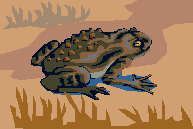|
|
|
"Friends/Enemies of the Frilly"
|
|
The frilled neck has very few predators where it lives. Because they are so fast, and have great camouflage they donít have many problems with predation. Larger lizards reside higher up in the trees, so the frilled neck resides in the lower portions of the tree. The frill neck accepts its niche in the environment, so competition with other species doesnít pose a problem.
The
frilled neck's biggest predator is humans. The number of frilled necks
has decreased significantly in the past couple of years due to land
clearings and fires in Australia. According to "Australian Advances" up
to 30% of the frilled neck population is lost due to bushfires. Even
though the population of frilled necks decreases, the ones that do survive have
greatly increased food availability, and better prosperity. Frilled necks are also kept as domesticated pets in many parts of the world. In captivity, frilled necks can experience a variety of diseases. These include gastro-intestinal disease, metabolic bone/vitamin deficiency, or respiratory disease. If the owner doesn't properly wash their hands, they can also spread Salmonella. To learn more about the frilled necks role in our lives follow me to frilly facts! |
|
Send comments about this page to Kim Acker |











